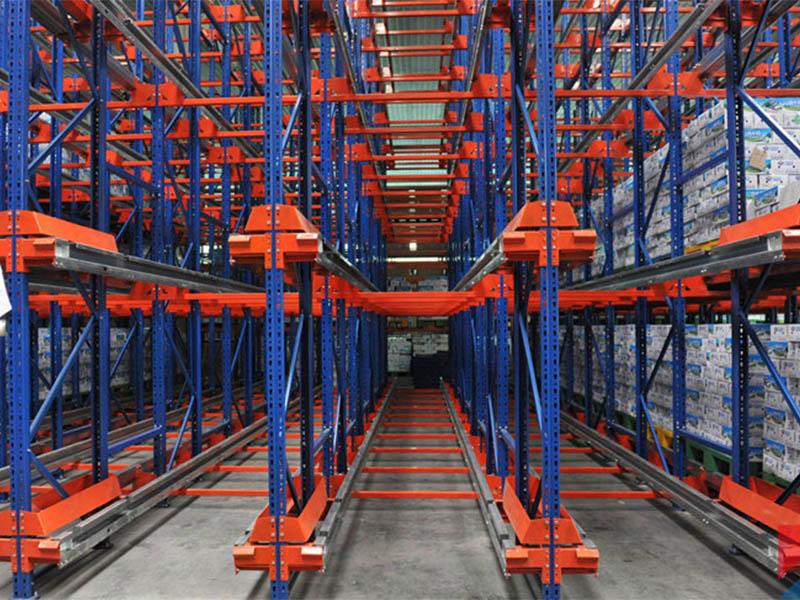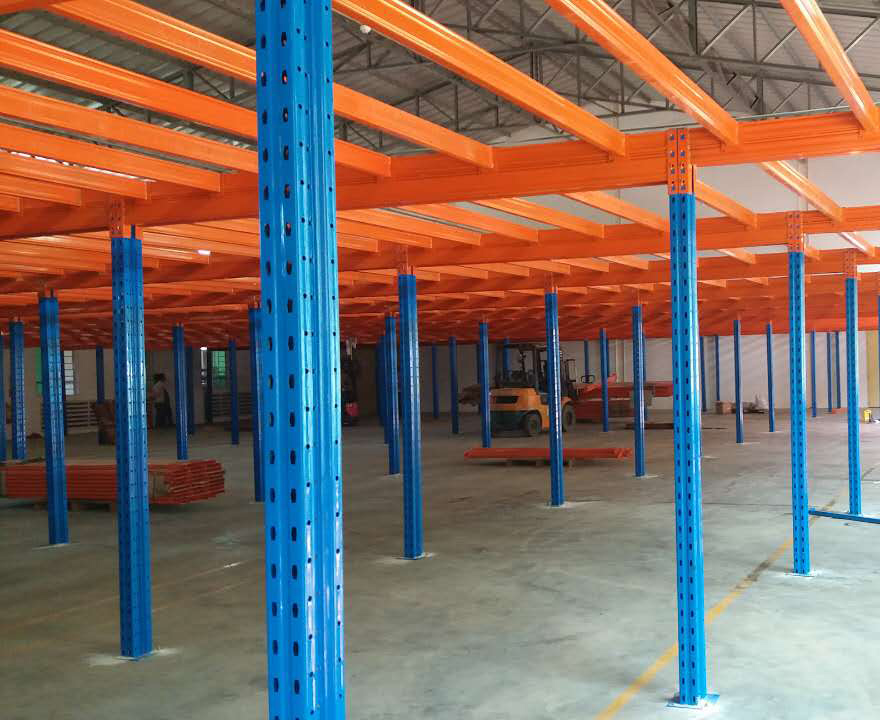In the relentless pursuit of warehouse efficiency, maximizing cubic space utilization is paramount. When pallet quantities are high relative to the number of SKUs, traditional selective racking can become space-prohibitive. This is where the drive in drive through racking system shines as a powerhouse solution for high-density storage. This article delves deep into seven crucial aspects of these systems, explaining their design, operation, benefits, and ideal applications to help you determine if they are the right fit for your operation.

At its heart, a drive in drive through racking system is a pallet storage solution designed for exceptionally high storage density by eliminating aisles between rows. Unlike selective racking where each pallet faces an aisle, these systems store pallets in multiple rows deep within a single lane. Forklifts literally "drive in" and "drive through" these lanes to deposit and retrieve pallets.
Drive-In Racking: This configuration typically has pallet lanes accessible from only one end. Forklifts enter the lane, place pallets on rails from the front to the back, and then exit the same way. Retrieval follows a Last-In, First-Out (LIFO) principle: the last pallet stored is the first one accessible. This is ideal for storing large quantities of identical products or products with low rotation where batch access is acceptable.
Drive-Through Racking: This configuration has lanes accessible from both ends. Forklifts can enter from one end to load pallets and exit through the opposite end, or vice-versa for unloading. This allows for First-In, First-Out (FIFO) inventory management. This is crucial for products with expiration dates, batch tracking requirements, or where stock rotation is essential.
The fundamental principle of the drive in drive through racking system is its reliance on the forklift operating within the rack structure itself, navigating on the building floor between the upright frames, to store pallets on rails or beams positioned at various levels. This deep lane storage dramatically increases the number of pallets stored per square foot compared to aisle-dependent systems.
A robust drive in drive through racking system comprises several key structural elements designed to handle significant loads and the dynamic forces of forklift traffic within the lanes:
Upright Frames: These are the vertical columns forming the ends of each storage bay and the sides of the lanes. They are typically heavier gauge steel than selective racking uprights to withstand potential impacts from forklifts operating in tight confines. They feature specially designed bracing and base plates for stability.
Guide Rails or Structural Beams: Instead of traditional horizontal beams supporting pallets from below, these systems primarily use continuous guide rails running the length of the lane at each storage level. Pallets rest directly on these rails. Some heavy-duty designs might use structural beams. These rails/beams must be precisely aligned and extremely robust.
Entry/Exit Guides: Heavy-duty diagonal bracing or specialized guide structures are installed at the entry and exit points of each lane. These protect the upright frames from forklift impacts and guide the forklift smoothly into and out of the lane.
Pallets & Floor: The system relies on uniformly sized, structurally sound pallets. The warehouse floor within the lanes must be perfectly level and possess adequate load-bearing capacity to support both the racking and the heavy forklifts traversing it constantly. Floor flatness is critical for safe operation and rail alignment.
Lane Depth & Height: The depth (number of pallet positions deep) and height (number of storage levels) are customized based on inventory profile, forklift capabilities (lift height, mast type), and building clear height. Deeper lanes increase density but can impact access times.
The structural integrity of every component within a drive in drive through racking system is non-negotiable, given the constant interaction with moving equipment inside the structure.
The operational dynamics of a drive in drive through racking system are fundamentally different from aisle-based systems:
Lane Entry: The forklift operator carefully aligns the truck with the designated lane entrance. Entry guides help position the mast correctly.
Navigation Within Lane: Once inside the lane, the forklift drives along the building floor, directly between the rack uprights. The operator must maneuver precisely, often with limited visibility, to position the forks at the correct storage level and depth.
Pallet Placement/Retrieval: For placement, the operator positions the pallet onto the guide rails at the desired location, ensuring it sits securely. For retrieval, the forks slide under the pallet resting on the rails, lift it, and carefully reverse out (Drive-In/LIFO) or drive straight through (Drive-Through/FIFO).
Height Considerations: Operators must be acutely aware of the mast height, especially when lifting or lowering pallets within the lane, to avoid collisions with the rails or uprights above.
Forklift Requirements: Specialized forklifts are often recommended or required:
Man-Down Turret Trucks: Offer the best combination of maneuverability, lift height, and operator visibility within the lanes. The operator cabin lowers with the forks.
Counterbalanced Forklifts: Can be used, especially in lower-height systems or Drive-Through lanes, but require highly skilled operators due to wider turning radii and mast obstruction.
Reach Trucks: Generally not suitable, as they require aisles to extend their forks and cannot operate within the rack structure.
Safety is paramount. Strict speed limits, clear lane occupancy protocols (only one forklift per lane!), operator training focused on spatial awareness and precision, and comprehensive rack protection are essential.

The primary driver for implementing a drive in drive through racking system is its unparalleled advantage in specific scenarios:
Exceptional Storage Density: This is the crown jewel benefit. By eliminating up to 85% of aisles required by selective racking, these systems can achieve storage densities 60-75% higher. This translates directly to maximizing warehouse space utilization and deferring costly expansion or relocation.
Reduced Storage Costs per Pallet: The high density achieved lowers the real estate cost associated with storing each pallet.
Ideal for Bulk Storage: Perfect for storing large quantities of the same SKU (homogeneous product) with low turnover or seasonal items. Drive-In excels here with LIFO.
FIFO Capability (Drive-Through): The Drive-Through variant provides the crucial FIFO access required for perishables, regulated goods, or products needing strict rotation.
Good Cube Utilization: Efficiently uses available building height, similar to other pallet racking systems.
Structural Durability: When properly designed and installed, these systems are built to withstand the rigors of forklift traffic within the lanes.
For operations focused on storing large volumes of fewer SKUs, the drive in drive through racking system offers a compelling space-saving solution.
While powerful, the drive in drive through racking system is not a universal solution and comes with inherent limitations:
Reduced Selectivity / Accessibility: Accessing a specific pallet deep within a lane (especially Drive-In/LIFO) requires moving pallets in front of it. This significantly slows down retrieval times for non-last-in pallets and increases handling costs. Not suitable for high-SKU, high-rotation environments.
Lower Throughput Speed: The process of carefully navigating into a lane, precisely positioning the load, and maneuvering out (or through) is inherently slower than picking directly from an aisle-facing position in selective racking. This impacts overall warehouse throughput.
Higher Forklift Skill & Equipment Cost: Operating safely and efficiently within the confined lanes demands highly skilled operators. Specialized equipment like turret trucks, while enhancing performance, comes at a premium cost compared to standard forklifts.
Increased Risk of Damage: The close proximity of forklifts to the rack structure dramatically increases the potential for accidental impacts, damaging both the rack and stored goods. Robust protection systems are mandatory and add cost.
Inventory Control Challenges: LIFO management (Drive-In) might not be desirable for all products. Accurately tracking specific pallet locations deep within a lane can be more complex. Requires excellent Warehouse Management System (WMS) integration.
Higher Initial Investment: While saving space, the structural components (heavier uprights, guide rails, protection) and often specialized MHE (Material Handling Equipment) lead to a higher initial cost per pallet position than selective racking. However, the cost per square foot of building space utilized is often lower.
Carefully weigh these limitations against the density benefits. If selectivity and speed are critical, other systems may be better.
Understanding where the drive in drive through racking system fits relative to other high-density options is crucial:
Vs. Selective Racking: Selective offers 100% selectivity and faster access but requires significantly more aisle space, resulting in much lower density. Choose selective for high-SKU, high-turnover operations.
Vs. Push-Back Racking: Push-back also offers density (typically 2-6 pallets deep) with LIFO access but uses carts on inclined rails. It provides better selectivity within a lane than drive-in (access only the front pallet) and potentially faster retrieval, but has lower maximum depth and higher cost per pallet position than drive-in. Drive-in is better for very deep lanes of identical product.
Vs. Pallet Flow Racking: Pallet flow uses gravity rollers for high-density FIFO. Excellent for high-throughput FIFO needs but has higher cost per pallet position, requires specific SKU separation per lane, and maintenance of the flow system. Drive-Through offers FIFO but with lower throughput than flow.
Vs. Mobile Racking: Mobile racking moves entire aisles on tracks, offering high density and 100% selectivity but with significantly higher cost, complexity, and slower access times as aisles must be opened. Drive-in is simpler and cheaper for deep storage of few SKUs.
Vs. Automated Options (AS/RS, Shuttle): Automated systems offer very high density and throughput but come with the highest capital investment and complexity. Drive-in/through is a manual, lower-cost alternative.
The drive in drive through racking system occupies a specific niche: the most cost-effective manual solution for achieving very deep lane storage (6+ pallets deep) of homogeneous products, especially where FIFO (Drive-Through) or LIFO (Drive-In) access is acceptable.
Successfully deploying a drive in drive through racking system hinges on meticulous planning and execution:
Thorough Needs Analysis: Precisely define inventory profiles (SKU count, pallet volume per SKU, turnover rates), required throughput, and access method (FIFO/LIFO). This dictates whether Drive-In, Drive-Through, or another system is best.
Professional Design & Engineering: Engage experienced racking engineers. They will calculate loads, design the structural components (uprights, rails, bracing), determine lane depths and heights, specify required forklift types (free lift height, mast type, dimensions), and ensure seismic/wind compliance if applicable. Never cut corners here.
Precision Installation: Installation must be exact. Rails must be perfectly level and aligned, uprights plumb, and connections secure. Poor installation leads to operational difficulties, safety hazards, and premature wear.
Comprehensive Rack Protection: Invest in high-quality, impact-resistant column guards, end-of-aisle protectors, and lane entry guides specifically designed for drive-in systems. This is not optional; it’s essential for asset protection and safety.
Specialized Forklift Procurement & Training: Procure forklifts suited for the task (turret trucks preferred). Implement rigorous, ongoing operator training focused on safe navigation within the confined lanes, precise load handling, spatial awareness, and adherence to speed limits and lane occupancy rules.
Robust Warehouse Management System (WMS): A strong WMS is vital for tracking pallet locations within deep lanes, managing LIFO/FIFO effectively, and optimizing putaway and retrieval paths.
Rigorous Inspection & Maintenance: Implement a strict, frequent inspection regime focusing on rail alignment, upright plumbness, connector integrity, and any signs of impact damage. Prompt repairs are critical. Include regular checks of forklift forks for straightness.
The drive in drive through racking system remains a vital tool in the warehouse optimization arsenal, offering unparalleled storage density for specific inventory profiles. By understanding its core concepts – the distinction between Drive-In (LIFO) and Drive-Through (FIFO), the robust structural design, the specialized operational workflow, the significant space-saving advantages, and the critical limitations regarding selectivity and speed – logistics managers can make informed decisions. When applied to the right application, such as bulk storage of homogeneous products with predictable access patterns, this system delivers exceptional value by maximizing the utilization of valuable warehouse cubic space. Careful planning, professional engineering, precise installation, and unwavering commitment to safety and operator training are the cornerstones of a successful and efficient drive in drive through racking system implementation.
 Wechat
Wechat
 Whatsapp
Whatsapp